How to Scale a Design Team: Guide (2025)
Discover strategies for scaling a design team, from hiring and onboarding to process optimization and fostering collaboration.

Growing a design team is both thrilling and stressful. In the early days, one or two designers carried the product on their backs, juggling research, wireframes, prototypes, and QA. As the product and user expectations grow, that model falls apart. Deadlines slip, quality drops and burn‑out creeps in. I’ve lived through that reality; at Parallel, we went from a lone designer to several squads. Without a plan, adding people only magnifies chaos. With a plan, you create a structure that lets designers do their best work.
This guide shares how to scale a design team thoughtfully and is based on real experience and current research. Nielsen Norman Group defines DesignOps as the orchestration of people, process and craft to amplify design’s value at scale. Superside’s 2025 survey found that 76% of creative leaders felt burned out and that half of their projects were labelled high priority. Aquent reports that more than 60% of design leaders felt unsupported by their executives and that cutting design resources reduced productivity by over 20%. Against this backdrop, understanding how to scale a design team well is essential.
Start with an honest assessment
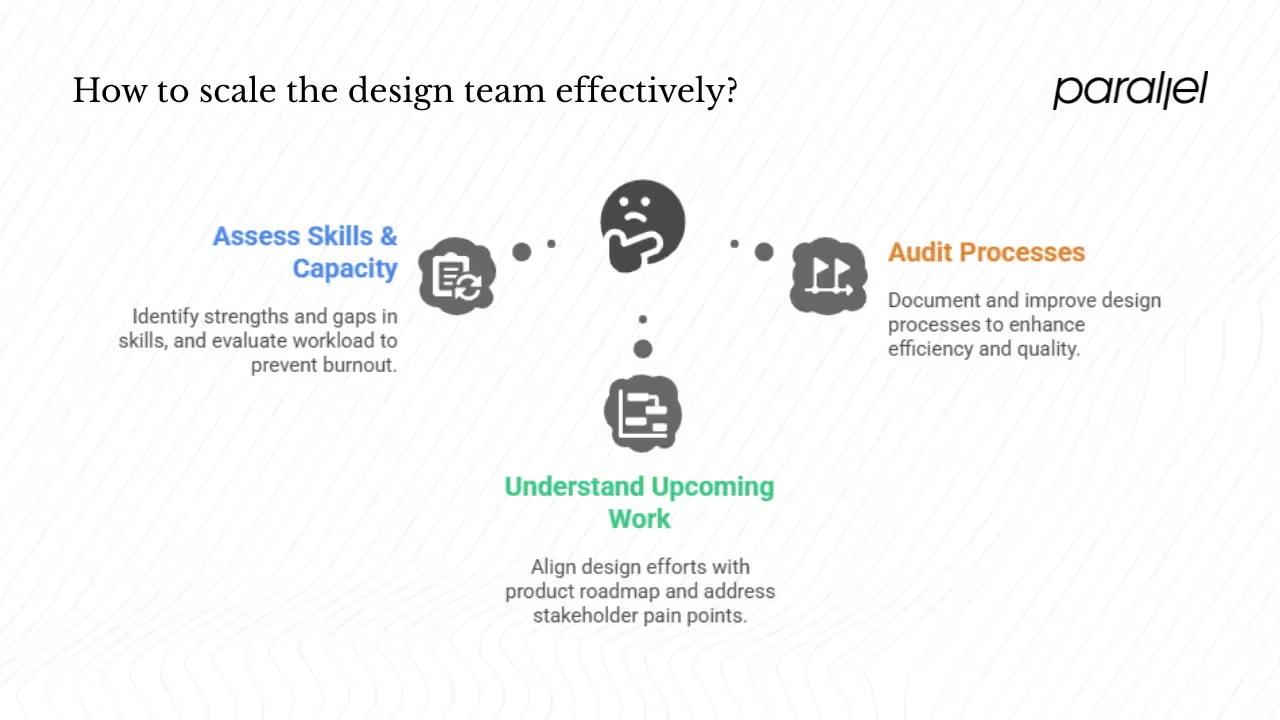
1) Check skills and capacity
First, map the skills you already have—research, interaction, visual, content, motion, accessibility, design systems and operations. Identify strengths and gaps. Next, look at workload. If your team is spending over 70% of its time on urgent production work and constantly context‑switching, they’re stretched. Superside’s survey found that about three‑quarters of creative leaders and their teams felt burned out and that 55% of their projects were labelled high priority Review cycle times and the number of parallel projects. If deadlines slip, scale is needed. When you’re mapping out these early diagnostics, think of it as the blueprint for how to scale a design team without burning people out. Taking the time to gather baseline data makes it easier to decide what to fix now versus later and keeps you anchored when the pressure to hire quickly sets in.
2) Understand upcoming work and stakeholders
Scaling design must fit the product roadmap. Look ahead and ensure new initiatives have enough design expertise. Ask stakeholders about pain points: Aquent’s research found that misalignment between design and product led to delays in more than half of teams and demotivation in 73%.
3) Audit processes
Document your design process from brief to handoff. Look at how requests are captured, who decides, when reviews happen, and how versions are managed. Nielsen Norman Group notes that DesignOps should address team growth, hiring, workflow efficiency and quality. A process audit shows where to improve before bringing in more designers.
Set a mission and shared values
People join a team because of its mission and stay because of its values. Write a clear statement about what the design team exists to achieve and how it behaves. Use short principles like “users first,” “ship and learn,” and “share openly.” Define norms around feedback and decision‑making. Create rituals—weekly critiques, pairing sessions, retrospectives—that reinforce these norms. Superside’s report found that 79% of professionals want to do bolder work but feel they’re racing against the clock. Building space for feedback and experimentation helps fight that pressure.
Choose a structure for scale
Centralized, embedded or hybrid

How you structure the team affects collaboration and consistency. In a centralized model, all designers report to one leader and work across multiple products. Awesomic’s 2024 guide notes that centralization provides oversight and consistent standards. The downside is slower decisions and weaker day‑to‑day product involvement. In an embedded model, designers sit within product squads, making decisions faster but risking inconsistency. Many companies choose a hybrid: designers are embedded but maintain ties to a central group for standards. Only 13% of teams surveyed by Nielsen Norman Group have formal DesignOps leads or managers, so appointing someone to handle tooling, hiring and process can make any structure work.
When to add managers
As your team approaches six or seven designers, the lead may struggle to coach everyone, plan work and fight fires. Introduce a design manager to handle day‑to‑day support and let the lead focus on vision. Create clear tracks for individual contributors and managers so people can progress without switching careers. Formalizing career paths is part of DesignOps. Establishing clear leadership roles is a foundation of how to scale a design team because it prevents decision bottlenecks and gives people confidence about their own growth.
Hiring and onboarding
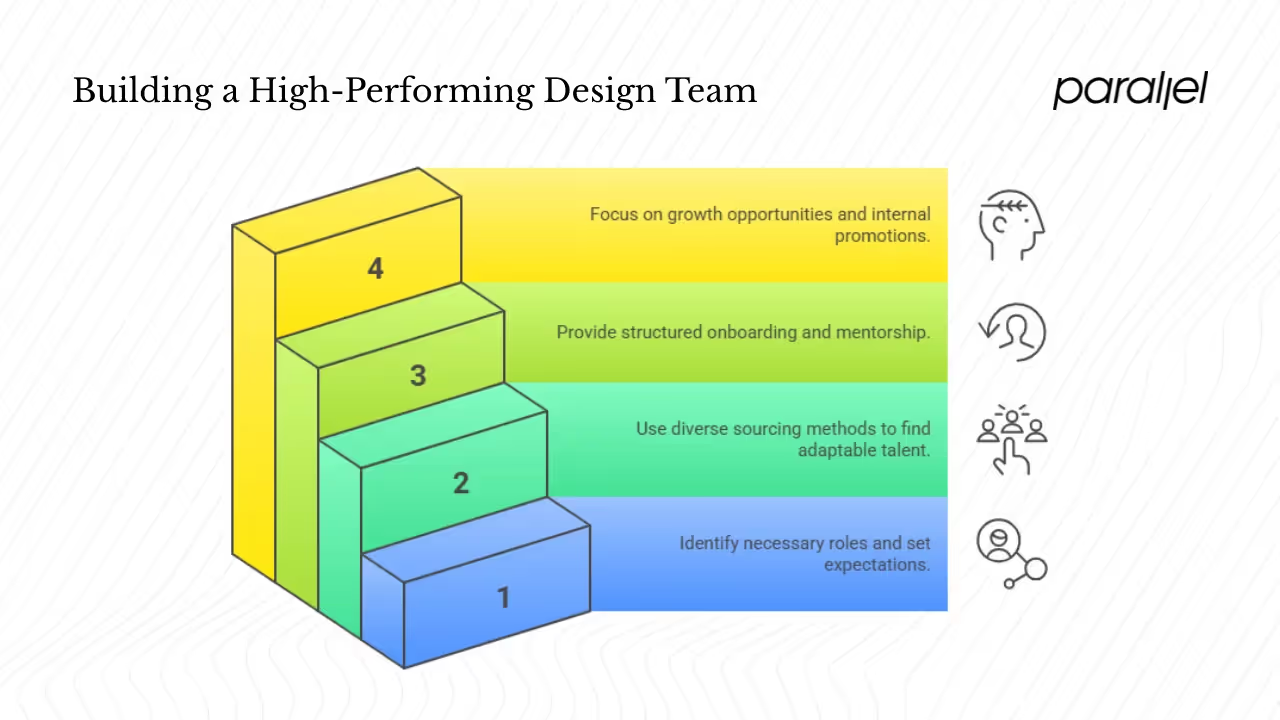
1) Define roles
Decide which roles you need based on your skills map, from generalists to researchers, content strategists, motion or accessibility specialists and operations managers. Define levels and expectations for each.
2) Attract and evaluate candidates
Use referrals, design communities and remote sourcing. Look for people with adaptability and a growth mindset; ask for examples of learning new tools. Strive for a mix of senior and mid‑level hires.
3) Smooth onboarding and mentorship
Create a checklist for the first week and month: tool setup, introductions, design process overview and pairing sessions. Provide a buddy to answer questions. Pairing and shadowing help new hires ramp up faster.
4) Retain and grow talent
Hold regular one‑on‑ones focused on growth, not just project status. Provide rotational assignments so designers can learn new domains and promote from within to maintain team identity. Superside’s report noted that 70% of leaders said their most skilled designers were working below their level; make sure senior people work on complex challenges while juniors handle production.
Resource allocation and workflow
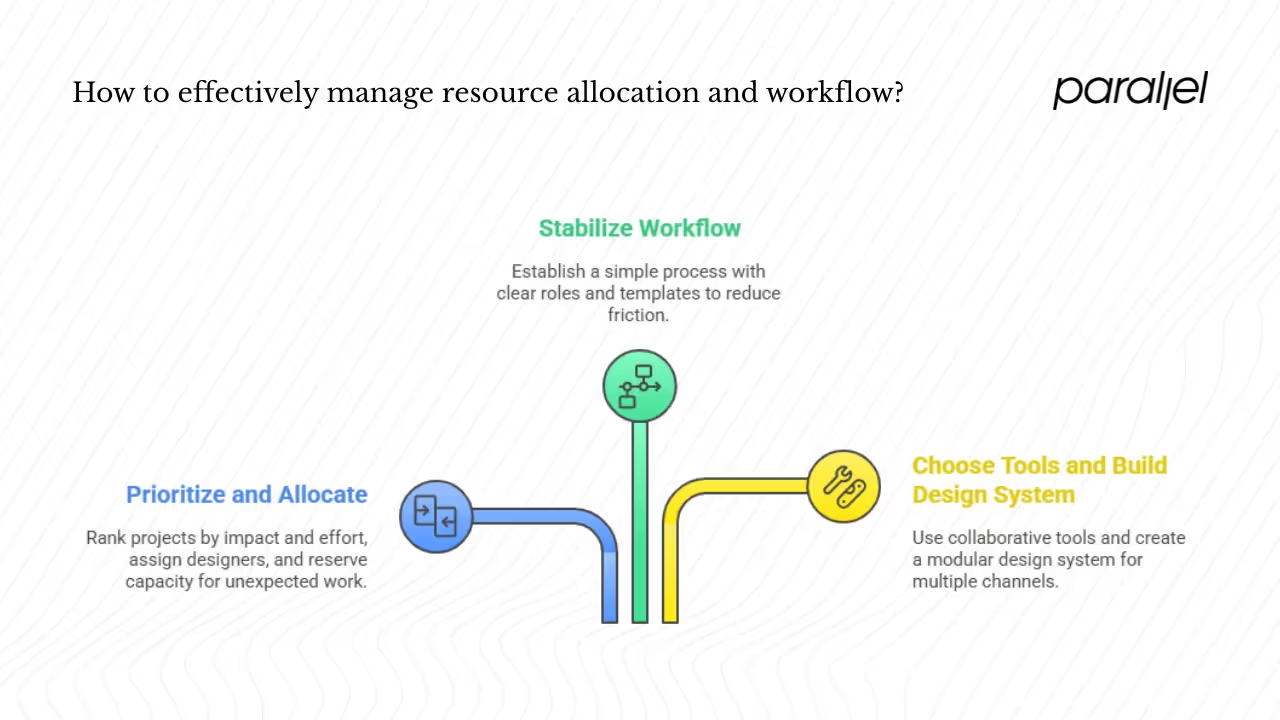
1) Prioritize and allocate
Work with products to rank projects by impact and effort. Assign designers accordingly and reserve about 20% of capacity for unexpected work and learning. Superside’s survey found that three‑quarters of leaders said creative demand exceeded capacity. Maintain a pool of “floaters” who can be assigned to spikes. When workload stays high, consider outsourcing tasks to freelancers. Superside reports that 52% of leaders outsource and 85% believe they need to do better at it. Outsourcing frees your team for strategic work. Knowing when and what to outsource is another example of how to scale a design team with limited resources.
2) Stabilize your workflow
Establish a simple process with stages—discovery, prototype, validation and handoff—along with clear roles, templates and review cycles. Standardization removes friction without forcing uniformity.
3) Choose tools and build a design system
Use collaborative tools like Figma, Miro, Notion and Slack. Build a modular design system that serves multiple channels and break it into subsystems to avoid bottlenecks. Document contribution guidelines.
Cross‑functional collaboration and leadership
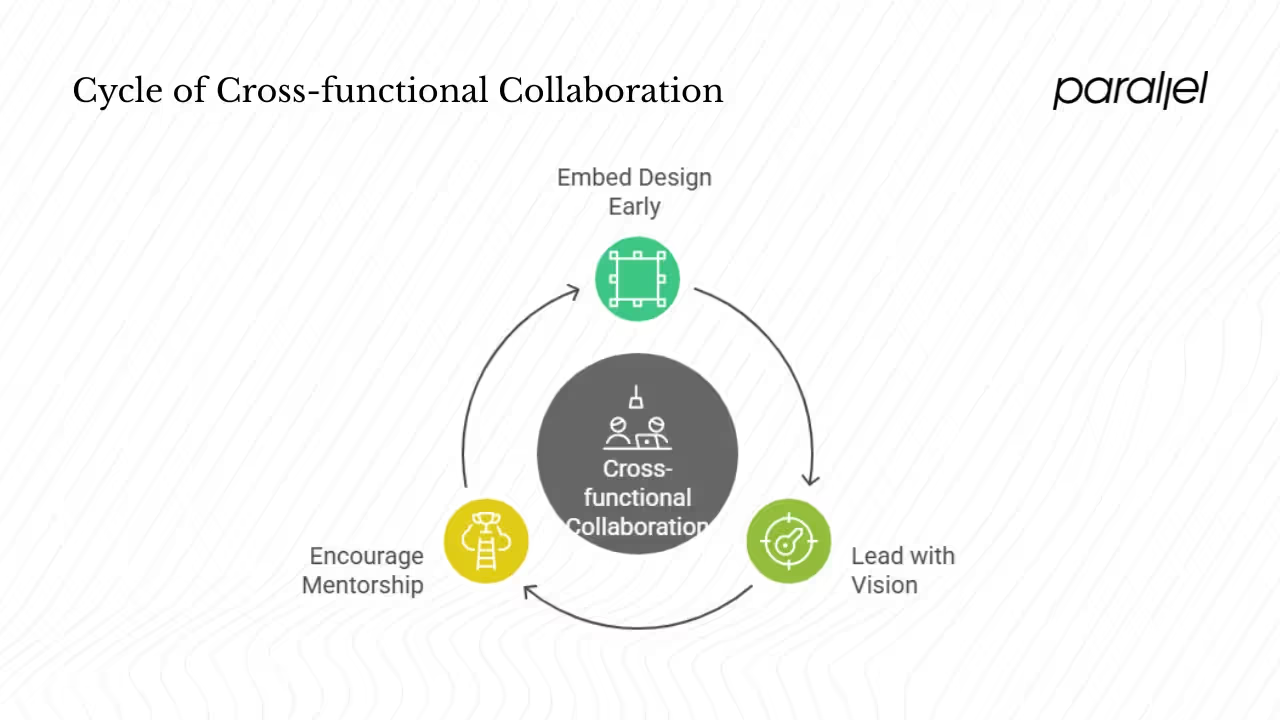
1) Embed design early and often
Involve designers in defining product goals, not just polishing screens. Hold regular syncs with product, engineering and data. Share design work through demos and show‑and‑tell sessions to build trust. Educate non‑designers about design thinking. Mural’s research shows that 85% of go‑to‑market teams report day‑to‑day misalignment and that 89% say collaboration failures hurt revenue. Good collaboration reduces rework and clarifies decisions. When you embed designers early in product discussions, you are learning to work across functions at scale.
2) Lead by setting direction and giving autonomy
Share context and vision, delegate thoughtfully and leave room for strategy and coaching. Clarify decision rights and document decisions to prevent endless debates.
3) Encourage mentorship and knowledge sharing
Host regular critiques and internal talks, and encourage juniors to teach new tools to seniors. These activities build connections and accelerate learning.
Measure and refine
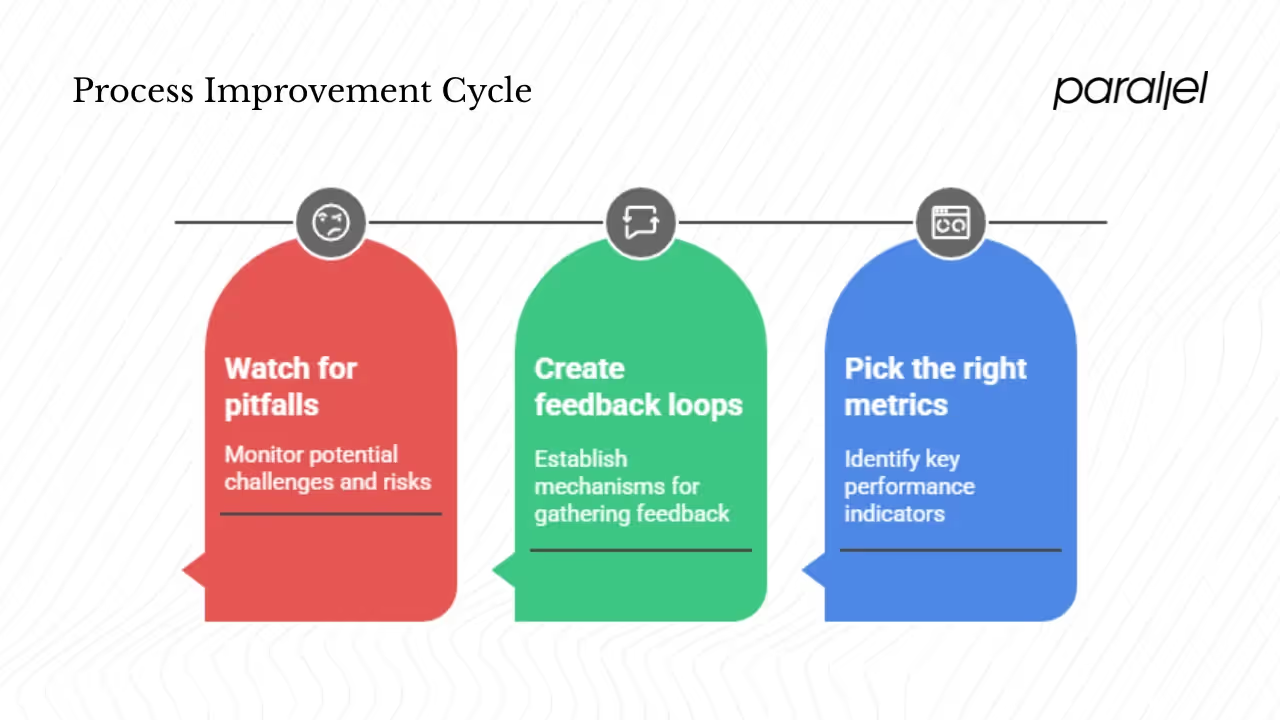
1) Pick the right metrics
Track throughput, cycle time, review turnaround, feature adoption, usability and conversion. Measure team health—satisfaction, retention and new hire ramp time—because Superside found that many creative leaders consider their teams understaffed yet still believe they have the skills to deliver. Also track design debt, the reuse of components and the ratio of planned to unplanned work. High unplanned work signals unclear scoping. Use these metrics to inform improvements rather than penalize individuals.
2) Create feedback loops
Run retrospectives at the end of projects to capture lessons. Meet quarterly to review processes: what templates and rituals work and which need refining. Conduct listening tours—short, informal conversations with designers to hear concerns and ideas. Nielsen Norman Group suggests internal research such as listening tours and stakeholder interviews to identify areas with the highest return on investment.
3) Watch for pitfalls
Growing too fast can dilute quality, while growing too slowly creates burnout. Avoid adding processes for its own sake, but don’t leave everything to chance. Allocate time to pay down design debt. Clarify roles so that founders don’t hold all decisions. More designers increase communication overhead; the right size is the one that meets your product needs.
Conclusion
How to scale a design team is not about chasing headcount; it’s about building structures and values that support great work. Start by assessing your skills and workload, define a mission, choose a structure, hire and onboard intentionally, refine workflows, build strong partnerships, and measure what matters. Each company will find its own pace and mix of centralized and embedded structures. Use this guide as a starting point and adjust it to your context. By taking one pillar at a time—whether it’s hiring, process or cross‑functional collaboration—you’ll learn how to scale a design team in a way that protects quality and keeps people energised. Start with an honest audit; the insights guide the next moves forward.
Frequently asked questions
1) When is it time to scale a design team?
Look for missed deadlines, frequent burnout, a growing backlog and stakeholder complaints. Superside’s report shows that creative demand often exceeds capacity. When quality drops or projects slip, invest in more designers or adjust scope.
2) How many designers before adding managers?
When a leader is directly supporting six or seven designers, it may be time to add a manager. Clear individual contributor and management tracks allow people to grow without changing careers.
3) Should designers be embedded in squads or centralized?
Both have benefits. Centralization delivers consistency and a broad view, while embedding accelerates decision‑making. A hybrid approach combines the two.
4) How to keep design consistent at scale?
Invest in a modular design system that serves multiple channels. Break it into smaller subsystems. Standardize tools and processes and hold regular reviews.
5) How to prevent design from being a bottleneck?
Reserve buffer time, maintain a floating pool of designers, and outsource tasks when needed. Give designers autonomy to make decisions without waiting for approvals.
6) Which metrics matter?
Track throughput, cycle time, rework rates, feature adoption, usability scores, new hire ramp time and team satisfaction. Use data to improve the practice, not to penalize individuals.
7) Is outsourcing bad when scaling design?
No. Over half of leaders outsource tasks and many want to improve their outsourcing strategy. Outsourcing allows your core team to focus on strategic work.
8) How to keep a team’s identity during fast growth?
Document norms and values, invest in rituals and pair new hires with buddies. A clear mission and shared practices bind people together even as the team grows.
9) Why does this guide matter?
Because it shows, in practical terms, how to scale a design team. The questions and examples throughout illustrate each step of the scaling process, turning a chaotic setup into a resilient practice that supports designers and improves products.









.avif)



